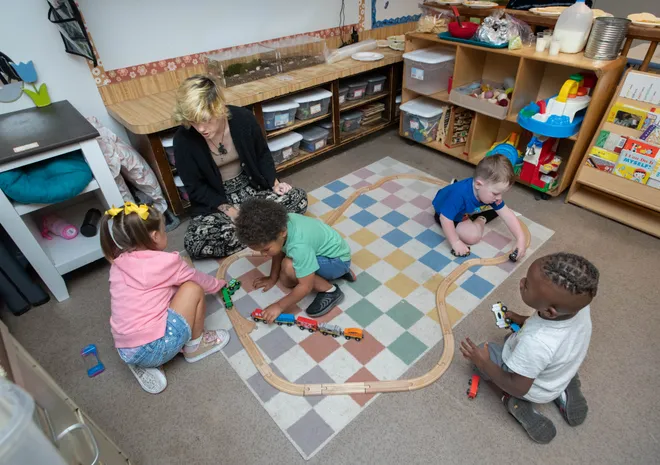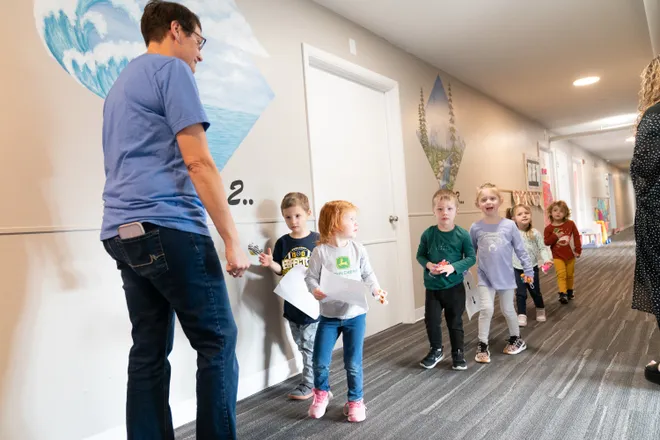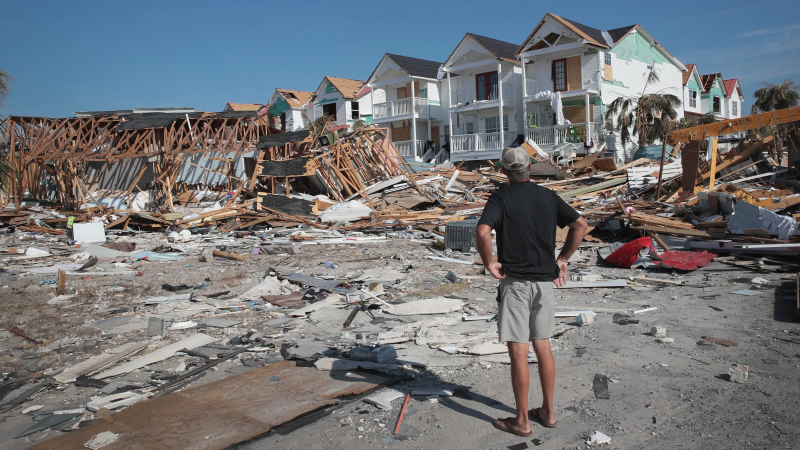Child care or rent? In these cities, child care is now the greater expense
Child care has grown so expensive that full-time care now costs more than rent in 16 of the nation’s 100 largest cities, according to a new report.
LendingTree, the personal finance site, compared the monthly cost of infant care with average rents for a two-bedroom home in big cities.
In quite a few cities, the analysis found, child care is the greater expense.
- In Syracuse, New York, child care costs $1,417 on average, LendingTree found. Monthly rent for a two-bedroom unit costs $1,126.
- In Spokane, Washington, child care averages $1,588 a month. Rent averages $1,304.
- In Minneapolis, child care costs $1,767 on average. Rent costs $1,622.
The LendingTree report, published Sept. 16, draws on child care figures from the nonprofit Child Care Aware of America and compares them with federal rent data.
It’s the latest in a string of surveys and studies to sound alarms on the rising costs of child care.

Child care costs have soared 220% since 1990
Child care costs have risen 220% since 1990, significantly outpacing inflation, according to the Annie E. Casey Foundation.
The average household that pays for child care spends $325 a week, or 18.6% of its weekly income, according to a recent LendingTree analysis. Another report, from the caregiver site Care.com, found that the average family spends 24% of its household income on child care.
Both figures exceed federal guidelines on what parents should pay for that service.
“When you see child care coming in at the No. 1 spot on the list of household expenses, beating out rent or even college tuition, you begin to understand the magnitude of this issue,” said Sean Lacey, general manager of child care at Care.com.
The rising costs of parenting figure prominently in a recent report from the surgeon general, which warns that stress on parents looms as “an urgent public health issue.”

Economic forces have stretched the child care industry
Several economic forces have pushed up costs and strained supply in the child care industry. One is inflation. Another is the COVID-19 pandemic, which shuttered thousands of child care centers. A third is the expiration last fall of pandemic-era federal funding for child care centers.
The LendingTree report draws attention to child care costs by comparing them with rents, which also are rising. Rent prices are one-third higher now than before the pandemic, according to Zillow.
Here are some of LendingTree’s findings:
- The average cost of full-time, center-based infant care in the 100 largest cities is $1,218 a month. For a family with an infant and a 4-year-old, the monthly cost rises to $2,182.
- Average rent for a two-bedroom home in those cities is $1,566: higher than the child-care costs for one child but lower than the costs for two.
- In 16 cities, child care costs for one child are higher than rent. Child care costs for two children exceed rent in 91 cities.
“The child care numbers have just gone up astronomically,” said Matt Schulz, chief credit analyst at LendingTree.

Parents debate: A second income or full-time child care?
Social media brims with accounts from parents weighing the math of a second income versus the costs of child care.
“My husband and I spend 50% of our take-home pay on the mortgage and daycare for 1 child,” a parent wrote in a Reddit discussion on parenting. “We couldn’t possibly afford another kid in daycare.”
Another parent wrote, “My wife and I work opposite shifts for this reason, and not seeing each other at all during the week is so taxing.”
A child care provider added this note: “The worst part is that we the teachers are getting maybe like $15 an hour, max.”
It might sound counterintuitive, given the high costs of child care, but experts say the child care industry is struggling.
“You find that the average child care center has a profit margin of 1½ percent,” said Leslie Boissiere, vice president for external affairs at the Annie E. Casey Foundation. According to the Bureau of Labor Statistics, the median hourly wage for child care workers is $14.60.

Child care salaries are low, profit margins thin
Child care salaries are low, and profit margins thin, in part because of state regulations that generally require high ratios of workers to children, according to Boissiere and other child care experts.
Another factor is real estate: A day care center in an affluent suburb might face the same high rents or mortgage costs as the affluent suburbanites who live there.
“Even though parents are paying these very high prices, child care providers are actually making very little money,” said Sandra Bishop, senior director of research at Child Care Aware of America.
Prohibitive child care costs drive many parents from the workforce, especially mothers. Research suggests child care costs are one reason women’s participation in the labor force has stalled in the United States while other affluent nations see continued growth.
In addition, tens of thousands of Americans are forced to stay home from work each month because of child care problems, according to federal labor data.
The nation’s “child care crisis” costs $122 billion in lost earnings, productivity and revenue every year, according to a 2023 report from the bipartisan Council for a Strong America.

'System is not working'
“The system is not working for anyone, really,” Bishop said. “Families can’t find child care. If they find care, it’s not affordable. It hurts parents, it hurts communities, it hurts businesses.”
Policymakers can help fix the system, experts said, by expanding funding for programs such as Head Start, which helps parents with early-education needs.
Another option is to invest more in Child Care and Development Block Grants, a federal program that helps low-income families afford child care. Only a small fraction of eligible families receive the grants, Bishop said.

Surgeon general's warning:Parenting may be hazardous to your health
States could increase the supply of child care workers by simplifying the licensing standards for home-based care providers, Boissiere said. Home-based care can be “a lot more affordable” than child care centers, she said.
The United States invests roughly $500 per child per year in child care, a 2021 New York Times analysis found. The average affluent country invests $14,000.
Child care serves “a triple bottom line,” Boissiere said. “Kids do well, parents can go to work and support their families, and the economy thrives.”
Disclaimer: The copyright of this article belongs to the original author. Reposting this article is solely for the purpose of information dissemination and does not constitute any investment advice. If there is any infringement, please contact us immediately. We will make corrections or deletions as necessary. Thank you.







